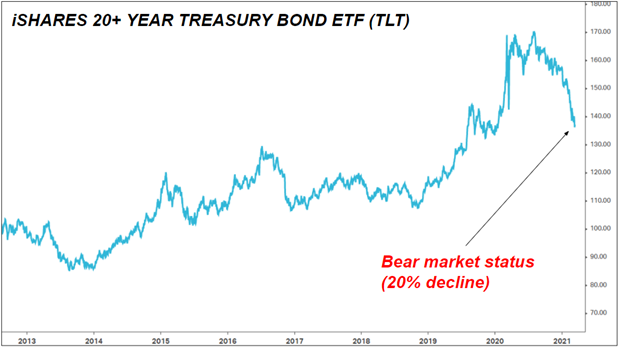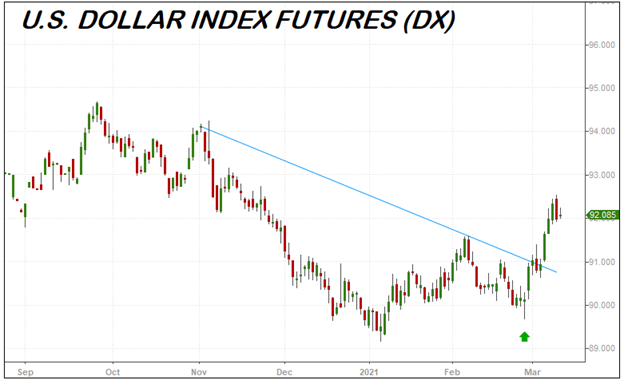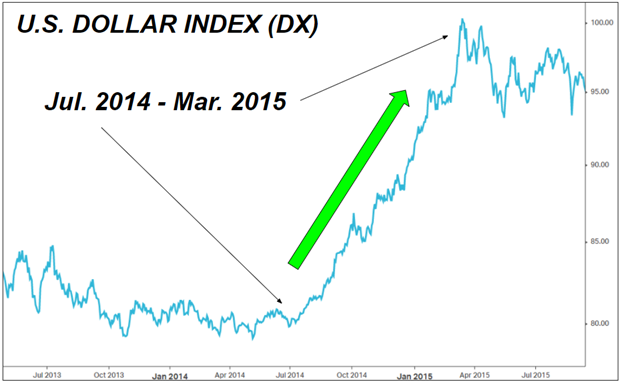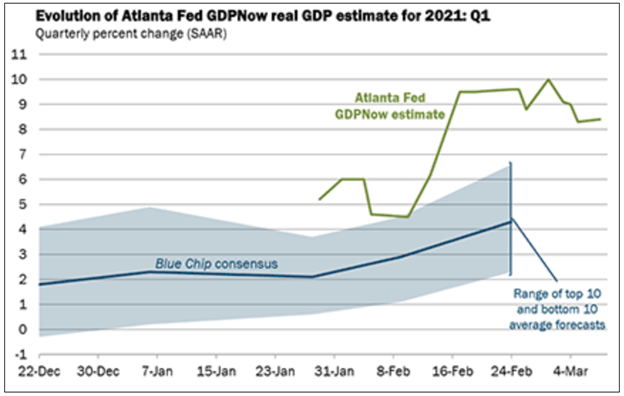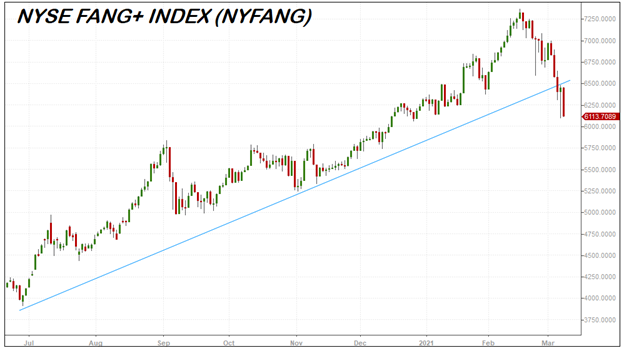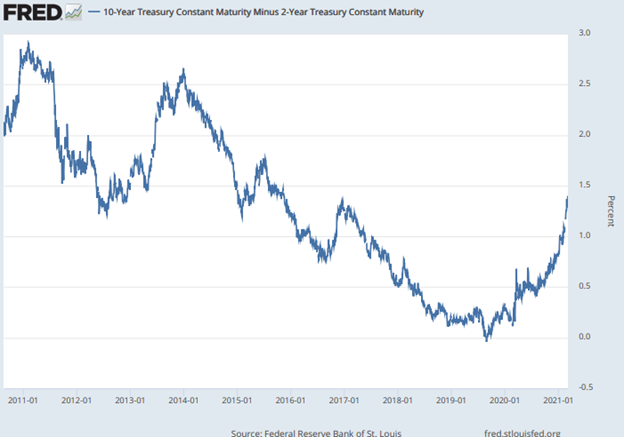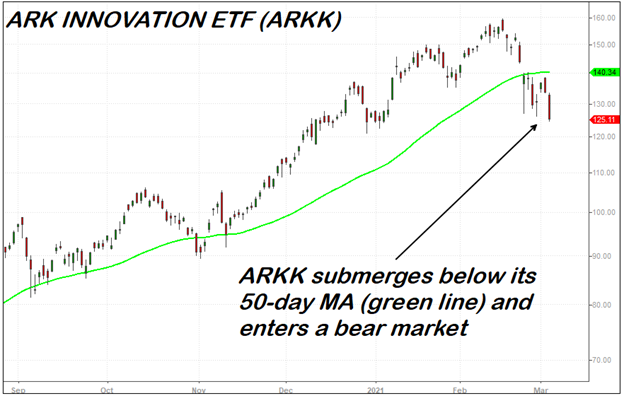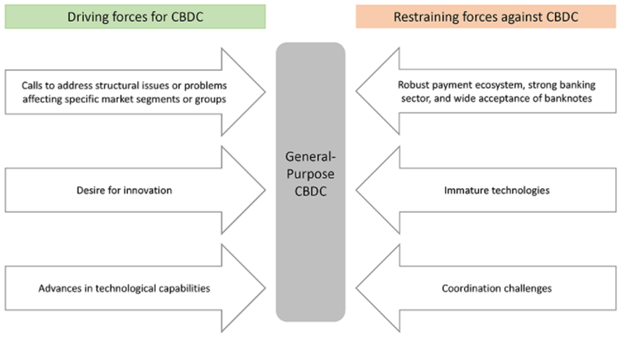Whereas a cat has nine lives, Bitcoin appears to have 400-plus and counting.
99Bitcoins, a crypto site, has a “Bitcoin Obituaries” page that tracks media declarations of Bitcoin’s death. There have been 403 “Bitcoin is dead” instances as of this writing — 10 of them in 2021 alone — with the oldest dating to Dec. 15, 2010.
And yet, for the second time in less than a month, Bitcoin has surpassed $1 trillion in market cap.
To benchmark Bitcoin against gold, the total value of the above-ground gold supply is presently just under $11 trillion; at $1 trillion in comparison, Bitcoin has an 8%-plus market share in the “physical gold versus digital gold” face-off.
We anticipate Bitcoin’s “digital gold” appeal to take further market share from physical gold over time, rising into the 25 to 50% range. Were Bitcoin to achieve a 50% market share versus gold, the Bitcoin market cap and the total value of the above-ground gold supply, as measured in U.S. dollars, would be equal.
Thanks to fiat currency creation and debt monetization over time, this parity between digital gold and physical gold could happen at much higher price levels. It is possible, for example, that one day both Bitcoin and gold are worth $16 trillion, for a digital-and-physical combined value of $32 trillion.
But getting back to the “Bitcoin is dead” talking point, Bitcoin was supposed to have died hundreds of times by now; instead it is demonstrably stronger than ever before.
For instance, there is ample evidence that Bitcoin’s latest gains are being driven not by retail interest, but increasingly widespread institutional adoption. Insurance companies with century-old pedigrees — some of the most conservative financial institutions on earth — are adding BTC to their asset mix. Investment banks like Goldman Sachs are scrambling to open (or re-open) crypto-focused trading desks. And white-glove banking institutions around the world are adding Bitcoin-related services to their private client mix (because clients are demanding that they do so).
Bitcoin’s critics desperately wanted it to die — and many of them still do — but the more rational ones have recognized they won’t be getting their wish. So, many of them are switching arguments.
More specifically, in recent weeks the “Bitcoin is Bad for the Environment” argument has taken on new life. The argument has been around for a while, but it is getting more attention now that the “Bitcoin is dead” talking point is, well, dead.
The thrust of the “Bitcoin is bad for the environment” criticism revolves around the power usage required for Bitcoin mining. Bitcoin is supposedly bad for the global energy grid — and awful for the climate — because of the shocking amount of electricity it requires to mine a single coin.
Some Bitcoin critics have gone even further, arguing that Bitcoin’s outsized energy use amounts to not just a waste of power, but an outright climate catastrophe, further implying the adoption and promotion of Bitcoin is a crime against humanity and the planet.
In our view, the “Bitcoin is bad for the environment” argument, as commonly presented, is non-serious. It is less of a real argument and more of a rhetorical weapon, and a way to criticize Bitcoin without thinking.
In this sense it is a substitute for the old “Bitcoin is dead” declaration; now that it is plainly obvious Bitcoin is not dead, “Bitcoin is bad for the environment” is a lazy substitute.
A logical debate relating to Bitcoin and energy use is certainly possible. It just needs to consider the nuanced mix of factors involved, rather than sensationalizing a handful of cherry-picked bullet points deliberately presented with no context.
For example, consider the reason Bitcoin mining uses tremendous amounts of power in the first place.
The implied suggestion is that Bitcoin’s power usage is just a flat-out waste, and an utterly pointless use of finite electricity stores. But this overlooks the fact that high power usage is a feature of Bitcoin’s design, not a bug, with respect to maintaining the integrity and security of the Bitcoin blockchain and ledger.
It takes a lot of power to mine new Bitcoins, in other words, because the proof-of-work process has to be inherently hard, if not flat-out impossible, to hack or counterfeit or fake. There is a direct relationship between computational power, physical computing power, and the amount of energy used.
This sounds wasteful until one considers the end result that is achieved: A globally decentralized digital asset, that can serve as an immutable store of value, with no need for physical security or physical world protection other than the processes embedded within the Bitcoin code.
That global store of value result is very hard to achieve. That is why Bitcoin, as digital gold, is the first store of value asset to present a legitimate challenge to physical gold; and it is also arguably why Bitcoin has a trillion-plus market cap in early 2021, after being declared “dead” hundreds of times.
Then, too, it is crucial to remember that physical gold achieves its security and immutability through its properties as a scarce metal that is hard to store, hard to transport, and hard to extract from the ground.
All of those activities — from storing physical gold in vaults, to shipping gold bars on airplanes or in armored trucks, to the environmentally destructive process of gold mining — should count toward gold’s “energy footprint” in terms of how much it costs to maintain physical gold as a global store of value.
So the first step in analyzing the Bitcoin energy footprint rationally is recognizing that Bitcoin’s power usage is a function of creating the decentralized security and scarcity Bitcoin has achieved; the second step is comparing that cost to the energy footprint (and environmental footprint) of gold.
For physical gold, the environmental footprint is separate from the energy footprint because there is a deeply destructive component of gold mining: You have to dig up gold where you can find it, which can often mean destroying a pristine bit of wilderness, introducing noxious chemicals into nearby groundwater, and using large amounts of local water — not to mention the shipping and refining processes. With Bitcoin there is no comparable footprint on the environmental side.
“Fine,” some environmentalists might say, “if physical gold is terrible for the environment, why not just use the monetary process enabled by central banks. The Federal Reserve and other central banks can create currency at the push of a button, without polluting anything or using huge stores of electricity.”
To that argument we would say: The fiat currency creation and protection process has a huge energy footprint, too — possibly the largest one of all.
To have a functional fiat currency system that operates on a global scale, you need a nation-state that issues the currency, which in turn requires a standing military equipped with missiles and warships and the like. Talk about an expensive footprint!
And then, to run a centralized fiat currency distribution system managed from the top down, connected to a network of banks, you need a huge investment in ongoing digital security measures, coupled with all manner of excursions into the physical world (think bank vaults, armored trucks filled with cash, servers to reconcile bank transactions, and so on).
The point here is not to say that the energy footprint of gold is bad or evil, or that the energy footprint of running and maintaining a large-scale fiat currency system is bad or evil.
Instead, the goal is to point out that criticizing Bitcoin’s energy footprint in a vacuum — without considering the benefit it offers in relation to alternatives like gold or fiat — is flat-out intellectually dishonest. To put Bitcoin’s power cost in perspective, one has to compare what Bitcoin offers to the pros and cons of alternative store-of-value systems, with the attendant costs factored in.
To stop considering Bitcoin’s energy footprint in a vacuum would be a big step in having an honest debate about Bitcoin’s value versus its environmental costs. But we can go much further.
For example, consider the fact that Bitcoin mining, as an economic activity, is geographically independent. From Canada to China to Siberia to South Africa, one can mine for Bitcoins anywhere.
This geographic variability is a hugely important feature, because it means Bitcoin miners — as free- market entities who pay for the electricity they use — will gravitate to areas where electricity costs are lowest. Nobody has to order the Bitcoin miners to do this, they have a rational free-market incentive to do it: If you are paying too much for electricity in your mining operation, you are hurting your profit margin.
That, in turn, makes Bitcoin mining a valuable means of absorbing surplus power creation in regions that have more electricity than the locals require for daily needs.
This is a common occurrence in areas where, say, hydropower accounts for a significant percentage of electricity generation, or where population density is low relative to large-scale power sources. If a region in, say, the Canadian wilderness has plenty of fast-moving water, but not a large population, it could make sense to mine Bitcoin there, because the surplus hydropower is available at a lower cost.
And this exposes another deception in the “Bitcoin is bad for the environment” argument: Looking at power usage as if all electricity is the same makes no sense. To the degree Bitcoin miners gravitate to regions with excess power generation, they are using power that otherwise may not have been used; that is very different than, say, competing for scarce electricity in high-demand, population-dense areas.
We can keep going: Think about a country that wants to lift itself out of poverty, but has no significant advantages other than a surplus of natural resources.
If this country chose to set up renewable energy facilities, it might be able to sell the electricity generated by those facilities to some free-market entity, creating jobs and local economic activity in doing so.
Ah, but electricity is nearly impossible to store and transport efficiently, so what type of free-market entity would have the ability to parachute into a geographically remote area and make immediate use of its low-cost, renewable-electricity-powered creation?
Enter crypto mining: An industry that, as we already noted, is 100% geographically independent.
To the extent that Bitcoin miners can gravitate to regions where renewable-energy electricity sources are created from scratch, crypto mining can add additional power to the global energy grid, while powering beneficial economic development in lower-income countries besides.
Then, too, the sufficiently motivated lower-income country we just described doesn’t necessarily have to mount a marketing campaign to attract Bitcoin miners, per se: It could simply recognize its undeveloped renewable energy capacity as a resource, and then start mining for Bitcoins itself.
And this segues to the last key point why the “Bitcoin is bad for the environment” argument is, quite frankly, incoherent to the point of bordering on silly: A globally flexible activity that facilitates the accelerated adoption of renewable energy is good for the planet, not bad for the planet, even if it uses large amounts of power as it goes.
Consider the fact that, in the space of one hour, the sun bathes the earth in enough energy to power human civilization for an entire year. Or consider the fact that, at current rates of efficiency, the entire world could be powered by an array of solar panels that would fit inside the state of Texas. (Then consider that solar panel efficiency is still increasing, even as costs are plummeting.)
The way forward for human civilization, we would argue, is not in wringing our hands and clinging to notions of artificial energy scarcity. Instead, it is accelerating our efforts to unleash the vast abundance that renewable energy sources can provide.
To the extent the planet is saved from destruction by more intelligent energy use, the saving will be done not by using less energy, but by being more efficient and smart in scaling up the energy mix that is deployed — which in turn means incentives to invest aggressively in low-cost renewables (like, say, an opportunity to build out a crypto mining industry) could have a net positive impact, not a negative one.
What’s more, encouraging renewable energy use through free-market-oriented activities (crypto miners don’t need government subsidies, just cheap electricity) is a good thing, not a bad thing, because the faster that renewable energy facilities are built out, the faster that production costs for renewable energy will fall.
(Rapid adoption of a technology at mass scale means lower costs through larger volumes of factory production, coupled with greater economic incentive to improve the technology through research and development).
What all of this means is that Bitcoin is arguably a friend to the environment, not an enemy, to the extent that, first, Bitcoin mining is a geographically independent activity that uses surplus power (which tends to be cheapest); second, that Bitcoin mining is potentially an economically beneficial activity that can encourage new sources of renewable energy development; and third, the faster we develop new renewable energy sources, the better it is for the planet (with Bitcoin mining adding to that demand in a free-market manner).
Given all the above, there is still plenty of scope for intelligent debate in regard to Bitcoin’s environmental impact and the cost of Bitcoin power usage. But that debate should focus on real questions, such as:
- How can we measure the difference between scarce energy usage (competing for electricity in high demand) and surplus energy usage (low-cost electricity that is functionally a surplus)?
- How can we weigh the positive impacts of Bitcoin mining and other forms of crypto mining as a beneficial economic activity, particularly for lower-income countries, if done in the right way?
- How can governments or local regions regulate crypto mining to avoid undesirable outcomes while facilitating positive ones — like requiring electricity sources to be renewable, for instance?
There are lots of ways the discussion can move forward, and likely will. But just declaring point-blank that “Bitcoin is bad for the environment” is not a way to move forward, and not even a real argument. It takes all of the nuanced aspects and ignores them in favor of a dumbed-down attack, perpetrated by those who lost their “Bitcoin is dead” cudgel and have now switched to a red herring — a means of distracting from the fact their obituaries were wrong.
